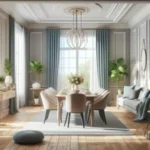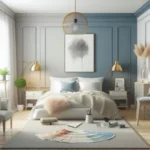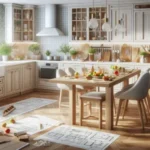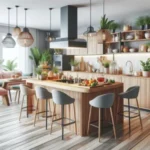The kitchen is often regarded as the heart of the home, a bustling hub where culinary creations come to life and memories are made over shared meals.
As the backdrop to countless family gatherings and intimate dinners, choosing the perfect paint color for this vital space can significantly influence its ambiance and functionality. With an overwhelming array of hues and shades to consider, from serene pastels to bold, vibrant tones, the decision can feel daunting. But fear not! In this ultimate guide, we’ll navigate the intricate world of color selection, exploring how light, space, and your personal style can harmonize to create a kitchen that is not only visually stunning but also a true reflection of your taste. Whether you’re aiming for a cozy farmhouse feel or a sleek modern aesthetic, join us as we uncover tips, tricks, and inspiration to help you make the right choice and transform your kitchen into a space you’ll love for years to come.
1. Understanding Color Psychology in the Kitchen
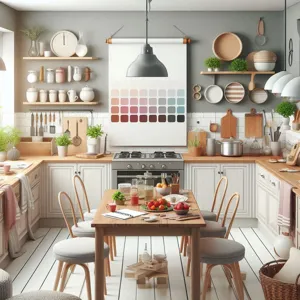
When it comes to selecting the perfect paint color for your kitchen, understanding color psychology is essential. Colors can evoke emotions, influence moods, and even affect our appetite, making them a crucial element in a space where we gather to cook, eat, and socialize.
In the kitchen, warm colors such as reds, oranges, and yellows stimulate energy and enthusiasm. These vibrant hues are often associated with warmth and comfort, making them ideal for fostering an inviting atmosphere. A splash of red can enhance appetite and conversation, while sunny yellows can inspire a cheerful ambiance, perfect for morning breakfasts or family dinners.
On the other hand, cooler colors like blues and greens promote calmness and relaxation. Soft blues can create a serene environment, making your kitchen a peaceful place to unwind after a long day. Greens, reminiscent of nature, can add a refreshing touch and bring a sense of balance to the space. These colors can be particularly appealing in open-plan homes where the kitchen flows into other areas of the house.
Neutral colors, such as whites, grays, and beiges, provide a timeless backdrop that allows for versatility. They can make your kitchen feel spacious and airy, while also serving as a blank canvas for colorful accents and decor. Choosing a neutral palette can be an excellent option if you prefer to change up your decor frequently or want to highlight special features in your kitchen.
Ultimately, the key to harnessing color psychology in your kitchen is to consider the atmosphere you want to create. Do you envision a vibrant, lively space or a calm, serene retreat? By thoughtfully selecting colors that align with your desired mood, you can transform your kitchen into not just a functional area, but a welcoming and emotionally resonant part of your home.
2. Assessing Your Kitchen’s Lighting
When it comes to choosing the perfect paint color for your kitchen, one of the most critical factors to consider is the lighting. The way light interacts with paint can dramatically alter the hue and ambiance of your space, so taking the time to evaluate your kitchen’s lighting is essential.
Begin by observing the natural light that floods into your kitchen throughout the day. Is your kitchen bathed in warm, golden sunlight in the morning, or does it receive cooler, bluish tones in the late afternoon? The direction your windows face plays a significant role; south-facing kitchens tend to be brighter and warmer, while north-facing ones can feel cooler and more subdued. By analyzing these variations, you can better predict how different colors will appear at different times of the day.
Next, consider your artificial lighting options. The type of bulbs you use—whether incandescent, fluorescent, or LED—can influence the paint color’s perception. Incandescent bulbs emit a warm, inviting glow that can enhance warmer paint shades, making them feel cozy and inviting. In contrast, fluorescent lighting tends to cast a cooler, more clinical light that can wash out warmer tones and accentuate cooler hues.
To truly understand how a color will look in your space, it’s advisable to test paint samples under various lighting conditions. Apply swatches of your chosen colors on the walls and observe them at different times of the day and under different lighting scenarios. This simple yet effective step will help you see how the paint interacts with your kitchen’s unique lighting, ensuring that you select a shade that not only complements your style but also enhances the overall atmosphere of the room.
By carefully assessing your kitchen’s lighting, you’re one step closer to achieving a harmonious and inviting space that reflects your personal taste and lifestyle.
3. Considering Your Kitchen Size and Layout
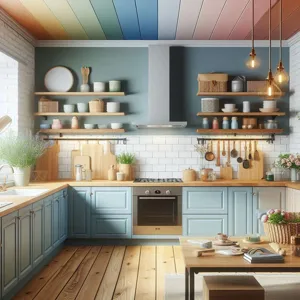
When it comes to selecting the perfect paint color for your kitchen, understanding the size and layout of your space is crucial. The dimensions and configuration of your kitchen can dramatically influence how colors are perceived and how they interact with the overall design.
In smaller kitchens, light and airy colors can create an illusion of space, making the area feel larger and more welcoming. Soft whites, pale blues, or gentle pastels reflect light and open up the room, providing a fresh, clean aesthetic. Consider using a satin or eggshell finish to enhance the light reflection, which can further brighten up cramped quarters.
On the other hand, larger kitchens offer more freedom in color choices. This is an opportunity to explore bolder hues that can add depth and character to the space. Rich shades like deep navy, forest green, or even vibrant reds can create a dramatic focal point, especially if the kitchen features an island or a unique architectural detail. However, it’s essential to balance these bold colors with lighter accents—perhaps in the form of cabinetry or backsplash—to maintain an inviting atmosphere.
Additionally, the layout of your kitchen can dictate how color transitions throughout the space. If you have an open-concept design that flows into adjacent rooms, consider how your chosen color will harmonize with neighboring areas. A seamless transition can enhance the overall flow of your home, while contrasting colors can define spaces but may require careful coordination to avoid clashing.
Finally, don’t forget about the natural light that enters your kitchen. A color that looks stunning in the afternoon sun may appear entirely different in the evening’s artificial lighting. Taking the time to test paint samples in various lighting conditions can provide a clearer picture of how your choices will ultimately look in your kitchen’s unique environment. By thoughtfully considering the size and layout of your kitchen, you can select a paint color that not only beautifies the space but also enhances its functionality and ambiance.
4. Exploring Current Kitchen Trends
When it comes to selecting the ideal paint color for your kitchen, keeping an eye on current trends can provide refreshing inspiration and help you create a space that feels modern and inviting. As you explore the latest kitchen design trends, you’ll find a dynamic range of color palettes and styles that cater to various tastes and aesthetics.
One of the hottest trends in kitchen design is the use of bold, deep hues. Rich colors like navy blue, forest green, and charcoal gray are making waves, adding an element of sophistication and warmth to the heart of the home. These darker shades can create a stunning contrast against white cabinetry or light countertops, offering a dramatic yet inviting ambiance.
On the flip side, soft pastels are also gaining popularity, providing a gentle touch that evokes a sense of calmness. Colors like mint green, blush pink, and pale yellow can brighten up your kitchen, making it feel airy and cheerful. These lighter shades work beautifully in smaller spaces, helping them feel larger and more open.
Another noteworthy trend is the return of earthy tones. Shades inspired by nature, such as terracotta, sage green, and sandy beige, are perfect for creating a rustic, organic feel in your kitchen. These colors not only connect your space to the outdoors but also work harmoniously with natural materials like wood and stone.
Additionally, don’t forget about the impact of two-tone kitchens, where contrasting colors are used to define different areas of the space. For instance, pairing a dark color on the lower cabinets with a lighter hue on the upper cabinets can add depth and interest, while allowing you to experiment with multiple shades without overwhelming the room.
As you consider your options, take time to browse design magazines, visit home decor websites, or even explore social media platforms like Pinterest and Instagram for the latest kitchen color inspirations. By staying attuned to current trends, you can choose a paint color that not only reflects your personal style but also positions your kitchen as a chic, contemporary gathering place for family and friends.
5. Choosing a Color Palette: Warm, Cool, or Neutral
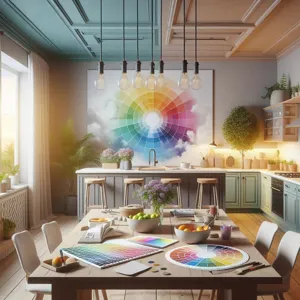
When it comes to selecting the right color palette for your kitchen, one of the most crucial decisions is whether to opt for warm, cool, or neutral tones. Each category offers distinct vibes and can significantly influence the overall atmosphere of your cooking space.
**Warm Colors**: Warm hues like reds, oranges, and yellows evoke feelings of comfort and energy. They can create a cozy environment that invites family and friends to gather. Imagine a rich terracotta for your walls paired with creamy white cabinetry, which not only encourages conversation but also stimulates appetite—the perfect recipe for a bustling kitchen. These colors are ideal for homes with a rustic or traditional decor style, as they harmonize beautifully with wooden accents and natural materials.
**Cool Colors**: On the other hand, cool tones such as blues, greens, and purples can introduce a sense of calm and tranquility to your kitchen. A soft sage green or a refreshing sky blue can make your space feel airy and spacious, perfect for smaller kitchens that may benefit from an illusion of openness. These colors work wonderfully in modern or minimalist designs, providing a serene backdrop against sleek appliances and contemporary fixtures. Additionally, cool colors can balance out warmer elements in your kitchen, creating a harmonious blend that feels both inviting and refreshing.
**Neutral Colors**: If you prefer a more understated approach, neutral colors like whites, grays, and beiges offer versatility and timelessness. A classic white kitchen exudes cleanliness and sophistication, while a warm beige can add a touch of coziness without overwhelming the senses. Neutrals provide a blank canvas that allows for easy experimentation with decorative elements, such as colorful dishware or vibrant artwork. This flexibility makes them an excellent choice for those who enjoy changing their decor frequently or want to ensure their kitchen remains stylish for years to come.
In choosing a color palette, consider not only your personal preferences but also the size and layout of your kitchen, the amount of natural light it receives, and how the chosen colors will complement your overall home decor. Each palette has its advantages, and the right choice can transform your kitchen from a simple cooking space into a welcoming hub of creativity and connection.
6. The Role of Cabinet and Countertop Colors
When it comes to choosing the perfect paint color for your kitchen, the hues of your cabinets and countertops play a crucial role in the overall aesthetic. These elements serve as the foundation of your kitchen’s design, influencing not only the mood but also the perceived size and lighting of the space.
Begin by considering the existing colors of your cabinetry and countertops. If you have dark wood cabinets or rich, textured countertops, lighter paint colors can create a beautiful contrast, making the room feel more open and inviting. Think soft creams, pale grays, or even a fresh mint green to brighten up the space and draw attention to your cabinetry’s natural beauty.
On the other hand, if your cabinets are painted a bright white or a light pastel, you might want to opt for bolder paint colors on the walls to add depth and character. A deep navy blue, a vibrant coral, or even a sophisticated charcoal can bring a modern flair to your kitchen while framing your cabinetry beautifully.
Additionally, consider the undertones of your countertops. A countertop with warm undertones works harmoniously with warm wall colors, such as buttery yellows or earthy terracotta shades. Conversely, cooler-toned countertops pair well with colors like soft blues or crisp whites, maintaining a cohesive and stylish look.
Don’t forget about texture, either. Glossy finishes on cabinets will reflect light and can enhance lighter wall colors, while matte finishes can soften the overall vibe.
Ultimately, the synergy between cabinet and countertop colors and your chosen paint can transform your kitchen into a cohesive space that feels both functional and inviting. Take the time to explore color swatches alongside your cabinet and countertop samples to visualize how they work together. This thoughtful approach will ensure your kitchen is not only beautiful but uniquely yours.
7. Testing Paint Samples: How to Do It Right
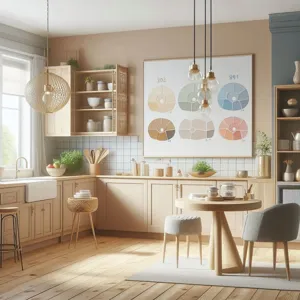
When it comes to selecting the perfect paint color for your kitchen, testing paint samples is an essential step that can make all the difference in achieving the look you desire. However, it’s not just about slapping a few swatches on the wall and calling it a day; there’s a method to the madness that can help you make the most informed decision.
First, choose a selection of colors that resonate with you, keeping in mind the overall theme and feel you want for your kitchen. Whether it’s a modern, sleek aesthetic or a cozy, farmhouse vibe, narrowing down your options will make the testing process more manageable.
Once you have your colors, purchase sample pots of your top choices. It’s best to opt for small quantities to avoid waste and unnecessary expense. Now, here comes the important part: application. Instead of painting a small swatch in one area, consider painting a larger rectangle—about two feet by two feet—on different walls or sections of your kitchen. This allows you to see how the color interacts with various lighting conditions throughout the day.
Observe how the paint looks in both natural light and artificial lighting. Colors can change dramatically depending on the time of day and the type of bulbs in your kitchen. Take note of how the color feels at different times—does it appear warm and inviting in the morning sunlight, or does it take on a cooler tone in the late afternoon?
Additionally, don’t forget to consider the other elements in your kitchen. Take a step back and assess how your chosen colors play off your cabinetry, countertops, and flooring. It can be helpful to have these materials on hand when testing so you can visualize the entire space cohesively.
Finally, be patient and give yourself the time to really see the colors in action. Live with the samples for a few days, or even a week, to truly understand how they fit into your lifestyle and routine. By taking the time to test paint samples thoughtfully, you’ll be better equipped to choose a color that you’ll love for years to come—one that reflects your style and enhances the heart of your home.
8. Coordinating with Adjacent Spaces
When selecting the perfect paint color for your kitchen, it’s crucial to consider how it will coordinate with adjacent spaces. The kitchen is often the heart of the home, acting as a bridge between living areas, dining rooms, and hallways. A well-thought-out color scheme can create a seamless flow throughout your home, enhancing the overall aesthetic and making every space feel connected.
Begin by assessing the colors and styles of the rooms that adjoin your kitchen. If your dining room is painted a deep, rich navy, you might want to choose a lighter shade of blue or a complementary color that harmonizes with it, such as soft gray or crisp white. This will not only create visual continuity but also ensure that each room feels inviting and cohesive.
Additionally, consider the materials and finishes in adjacent spaces. For instance, if your living room features warm wooden tones, you may want to opt for a warm, earthy paint color for your kitchen—think terracotta or creamy beige—to echo that warmth and create a welcoming atmosphere. If you have an open-concept layout, remember that the kitchen color will be more visible and can impact the perception of space, so keep transitions in mind.
You can also experiment with colors that create contrast—like a bold kitchen color that pops against neutral tones in the living area—while maintaining a balance that feels intentional rather than jarring. Using color swatches to see how different shades interact with the light and surrounding colors at various times of day will help you make an informed choice.
Lastly, don’t forget about the decorative elements, such as artwork and furniture, that will be seen in both areas. These pieces can help tie your color choices together, allowing you to strike the perfect balance between individuality and coherence across your home. By thoughtfully coordinating your kitchen paint color with adjacent spaces, you’ll create an atmosphere that feels curated and harmonious, inviting family and friends to gather and enjoy the warmth of your home.
9. The Importance of Finish: Matte vs. Gloss
When it comes to selecting the perfect paint color for your kitchen, the finish you choose can be just as crucial as the color itself. The finish not only affects the overall aesthetic but also influences durability, maintenance, and the way light interacts with your space. Understanding the differences between matte and gloss finishes can help you make an informed decision that aligns with both your style and practical needs.
**Matte Finish:** Matte paints offer a soft, velvety appearance that can create a warm, inviting atmosphere in your kitchen. They excel at hiding imperfections in walls, making them a popular choice for older homes or those with textured surfaces. However, while matte finishes can contribute to a cozy vibe, they may not be the best option for high-traffic areas like kitchens. They tend to be less washable and can show stains more easily, requiring more frequent touch-ups. If you lean toward a matte finish, consider using it in areas that are less prone to splatters, such as on upper cabinets or accent walls.
**Gloss Finish:** On the other hand, gloss paints are known for their reflective qualities, which can brighten up a space by bouncing light around the room. This finish is highly durable and easy to clean, making it an excellent choice for kitchens where spills and splatters are a part of daily life. Glossy surfaces can withstand scrubbing and are less likely to retain stains, making them ideal for lower cabinets, trim, or even the walls around your cooking area. However, they can highlight imperfections, so proper wall preparation is essential before application.
Ultimately, the choice between matte and gloss finishes will depend on your kitchen’s design, your lifestyle, and the overall vibe you want to create. Many homeowners choose to combine finishes, using matte for a serene backdrop while incorporating gloss on cabinetry or trim for a touch of sophistication. Whatever you decide, understanding the characteristics of each finish will empower you to create a kitchen that not only looks beautiful but also stands the test of time.
10. Tips for Small Kitchens: Making Colors Work
When it comes to small kitchens, the right color choice can make all the difference between a cramped, claustrophobic space and a bright, airy haven. The key is to opt for hues that create an illusion of space while still reflecting your personal style. Here are some essential tips for making colors work in your small kitchen.
**1. Embrace Light Colors:** Lighter shades, such as soft whites, pale grays, and gentle pastels, can significantly enhance the sense of space. These hues reflect more natural light, making your kitchen feel larger and more open. Consider a creamy off-white for the walls paired with crisp white cabinetry to create a seamless, expansive look.
**2. Use a Monochromatic Palette:** A monochromatic color scheme—where you choose varying shades of a single color—can also work wonders in small spaces. This approach creates a cohesive and harmonious environment. For instance, a palette of soft blues can range from a delicate sky blue on the walls to deeper navy accents in your kitchen accessories.
**3. Add Depth with Dark Accents:** While light colors are essential, incorporating darker accents can add depth and character to your small kitchen. Think about using a navy or charcoal gray for an accent wall, or opt for darker cabinetry to create a focal point that draws the eye. Just remember to balance darker hues with lighter elements to maintain a sense of openness.
**4. Create Contrast with Hardware and Accessories:** Incorporating contrasting colors through your kitchen hardware and accessories can bring both interest and personality to your small kitchen. For example, sleek black handles on white cabinets or colorful dishware on neutral shelves can provide visual intrigue without overwhelming the space.
**5. Consider Reflective Surfaces:** Glossy finishes, such as high-gloss paint or mirrored backsplashes, can amplify light and create a more spacious feel. These reflective surfaces not only brighten the area but also add a touch of elegance and sophistication, making your small kitchen feel more upscale.
**6. Use Accent Colors Wisely:** If you’re eager to incorporate bold colors, do so strategically. Choose one or two accent colors to highlight specific areas, like a cheerful yellow for your kitchen island or vibrant green for your bar stools. This way, you can inject personality into your space without overwhelming it.
By thoughtfully selecting your color scheme and utilizing these tips, you can transform your small kitchen into a stylish and inviting space that feels larger than life. Embrace the challenge of working with limited square footage, and let your creativity shine through with a color palette that perfectly suits your taste and lifestyle.
11. Incorporating Bold Colors vs. Subtle Shades
When it comes to choosing the perfect paint color for your kitchen, the decision often boils down to a captivating tug-of-war between bold colors and subtle shades. Each approach brings its own unique advantages and can fundamentally alter the atmosphere of the space.
**Incorporating Bold Colors:**
Daring to embrace bold colors can transform your kitchen into a vibrant focal point of your home. Shades like fiery reds, deep blues, or radiant yellows can inject personality and energy into the room, making it a lively place to gather and create. Bold colors can evoke feelings of warmth and excitement, sparking creativity in your culinary endeavors. Imagine a bright citrusy orange accent wall paired with sleek white cabinetry; the result is a kitchen that feels both modern and invigorating. However, it’s important to balance these vivid hues with neutral tones in your furnishings or decor to avoid overwhelming the space.
**Opting for Subtle Shades:**
On the other hand, subtle shades offer a calming and timeless elegance that can make your kitchen feel spacious and serene. Soft pastels, muted grays, and gentle earth tones can create a soothing backdrop, allowing for versatility in accessorizing and styling. These colors serve as a blank canvas, enabling you to experiment with bolder kitchen accessories, such as colorful dishware or striking artwork, without clashing. For instance, a pale sage green paired with natural wood accents can bring a touch of the outdoors inside, creating a fresh and inviting atmosphere. Subtle shades also tend to be more forgiving and can easily adapt to changing trends, ensuring your kitchen remains stylish for years to come.
Ultimately, the choice between bold and subtle colors should reflect your personality, lifestyle, and the overall aesthetic you wish to achieve. Whether you decide to make a statement with vibrant tones or cultivate an oasis with soft hues, the right paint color will breathe new life into your kitchen, making it a place where memories are made and shared.
12. DIY vs. Hiring a Professional: What to Consider
When it comes to choosing the perfect paint color for your kitchen, one of the most significant decisions you’ll face is whether to tackle the project yourself or bring in a professional. Each option has its merits and pitfalls, so let’s break down what to consider before making your choice.
**DIY: The Creative Freedom and Cost Savings**
If you’re a hands-on kind of person or simply looking to save some money, a DIY approach can be incredibly rewarding. Choosing to paint your kitchen yourself allows you to experiment with colors and techniques, providing the opportunity to express your personal style without the constraints of someone else’s vision. You can take your time, test various shades on the wall, and make adjustments as inspiration strikes. Plus, you’ll have the satisfaction of knowing you completed the project with your own two hands.
However, DIY painting isn’t without its challenges. It can be physically demanding, requiring you to move furniture, tape edges, and spend hours applying paint. For those without experience, achieving a polished finish can be tricky, and what starts as a fun project may turn into a stressful ordeal. Also, consider the time commitment; painting a kitchen can take longer than expected, especially if you’re new to the process.
**Hiring a Professional: The Expertise and Efficiency**
On the other hand, hiring a professional painter can take the weight off your shoulders. Professionals bring a wealth of experience, ensuring that the job is done efficiently and to a high standard. They’re familiar with different types of paint finishes, know how to handle tricky areas like cabinets and trim, and often have access to better quality tools and materials that can result in a more durable and attractive finish.
While hiring a pro may come with a higher upfront cost, think of it as an investment in your home. A beautifully painted kitchen can significantly boost your property value, making it a worthwhile expense. Moreover, professionals can often work around your schedule, ensuring minimal disruption to your daily life.
**Final Thoughts**
Ultimately, the decision between DIY and hiring a professional depends on your budget, time constraints, and confidence in your painting skills. If you choose to go the DIY route, be sure to arm yourself with the right tools and take your time to achieve the desired outcome. Conversely, if you opt for a professional, do your research, read reviews, and select someone whose style aligns with your vision. Whichever path you take, the right paint color will transform your kitchen into a space you love, so consider all angles before making your choice!
13. Common Mistakes to Avoid When Choosing Paint Colors
When it comes to selecting the perfect paint color for your kitchen, avoiding common pitfalls can save you time, money, and the dreaded regret that often comes with hasty decisions. One of the most frequent mistakes is neglecting to test colors in your space. Lighting plays a crucial role in how a color appears; a shade that looks stunning on a paint chip may look entirely different on your walls. Always sample a few swatches and observe how they change throughout the day as natural light shifts.
Another common blunder is failing to consider the kitchen’s existing elements, such as cabinetry, countertops, and appliances. Choosing a color that clashes with these features can create a disjointed look. Instead, aim for a palette that complements or contrasts harmoniously with your kitchen’s permanent fixtures, creating a cohesive and inviting atmosphere.
Overlooking the impact of emotion is yet another mistake. Color influences mood, so think carefully about the experience you want to create. Do you envision a calm and soothing space for family gatherings, or a vibrant and energizing environment for entertaining guests? Lastly, don’t shy away from going bold. Many homeowners opt for safe, neutral choices out of fear of making a mistake. However, incorporating an unexpected pop of color can add personality and flair to your kitchen, transforming it into the heart of your home.
By being mindful of these common mistakes, you can confidently navigate the world of paint colors and achieve a beautiful, functional kitchen that reflects your personal style.
14. Final Touches: Accessories and Decor that Complement Your Color Choice
Once you’ve settled on the perfect paint color for your kitchen, it’s time to elevate the space with thoughtfully chosen accessories and decor that harmonize with your color palette. The right finishing touches can transform a simple kitchen into a stunning culinary haven, enhancing both functionality and aesthetic appeal.
Start with the essentials: consider your kitchenware and appliances. If you’ve opted for a soft, pastel hue, complement it with vibrant, colorful accents—think striking red dish towels or bright yellow canisters. Conversely, if your walls are painted in a bold, dark shade, lighter accessories can create a beautiful contrast. Metallic finishes—like copper, brass, or stainless steel—can also add a touch of elegance and warmth, particularly against deep colors.
Next, don’t forget about textiles. The right curtains, table linens, or even chair cushions can play a significant role in your kitchen’s overall feel. Choose patterns that incorporate your wall color or go for complementary shades that add depth. For instance, if your kitchen features a serene blue, soft beige or cream accents can evoke a tranquil coastal vibe.
Wall art and decorative items should also be considered. Open shelving provides the perfect opportunity to display vibrant dishware or artful cookbooks that echo your chosen colors. Adding plants—whether it’s a vibrant herb garden on the windowsill or a striking centerpiece—can breathe life into the space while tying in natural elements that enhance your color scheme.
Finally, lighting is crucial. A well-placed pendant light or a stylish chandelier can not only illuminate your kitchen but also serve as a statement piece that ties together your color choices. Pay attention to the type of light bulbs you use, as they can dramatically influence how your paint color appears throughout the day. Warm bulbs can soften a stark palette, while cooler tones can enhance brighter shades.
By carefully selecting accessories and decor that complement your paint color, you can create a cohesive and inviting atmosphere that reflects your personal style, ensuring that your kitchen is not only a place for cooking but also a warm and welcoming space for gathering and entertaining.
15. Conclusion: Creating a Cohesive Look for Your Kitchen
In conclusion, creating a cohesive look for your kitchen is not just about selecting the right paint color; it’s about weaving together a harmonious blend of design elements that reflect your personal style and enhance the functionality of the space. The kitchen is often the heart of the home, where family and friends gather, so it’s essential that the atmosphere feels inviting and well thought out.
As you consider your paint choices, think about how they interact with your cabinetry, countertops, and flooring. A successful color palette should not only complement these features but also create a flow that extends into adjacent rooms, especially in open-concept designs. Whether you lean towards soothing neutral tones, vibrant hues, or a combination of both, your color selection should evoke the mood you desire—be it calm and serene or energetic and lively.
Don’t forget to factor in the natural light your kitchen receives throughout the day. Colors can shift dramatically under different lighting conditions, so it’s crucial to test your chosen shades at various times to ensure they maintain their appeal. Sample swatches can help you visualize how the colors will interact with the space and the overall aesthetic.
Finally, remember that layering textures and adding accents—such as backsplashes, hardware, and decorative elements—can further enhance the cohesive look you’re striving for. By thoughtfully selecting your paint color as part of a larger design strategy, you’ll create a kitchen that not only looks stunning but also feels like a true reflection of your home and lifestyle. Happy painting!
As we conclude our ultimate guide to choosing the perfect paint color for your kitchen, we hope you feel inspired and equipped to embark on this transformative journey. The right color can breathe new life into your space, reflecting your personal style while creating an inviting atmosphere for family and friends. Remember to consider the natural light, existing elements, and the overall mood you want to evoke as you make your selection. Whether you opt for a bold statement or a serene backdrop, your kitchen will not only be a culinary haven but also a reflection of your taste and creativity. So grab those swatches, envision your dream space, and get ready to unleash your inner designer—your perfect kitchen awaits!

